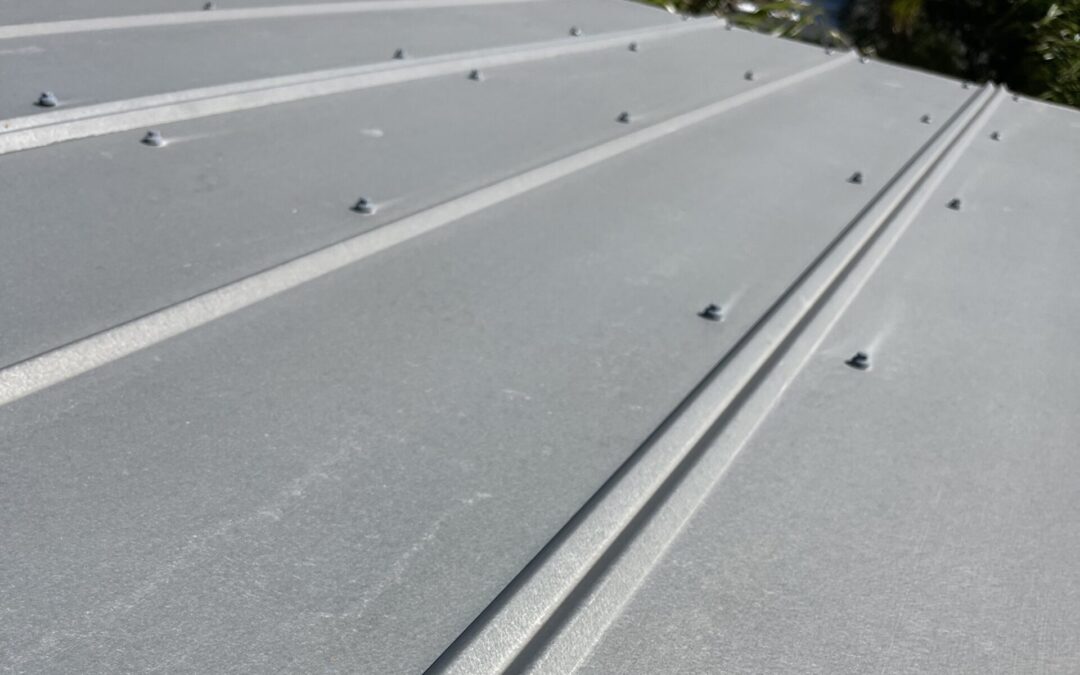Metal roofs make sense in Tampa Bay. They handle sun, wind, and sudden rain. But the install has to be right. Small mistakes turn into leaks and early rust.
Our coast adds pressure. Salt air rides in from the bay. Attic heat builds by mid-afternoon. Gutters clog with oak leaves after storms. Any weak spot shows fast.
Good choices up front prevent trouble. The right panel and coating. Solid underlayment. Straight screws with clean gaskets. Smart flashing at valleys and skylights. Plus permits and wind ratings that match Florida rules.
This guide maps the pitfalls and how to avoid them when installing metal roofing in Tampa, St. Pete, and Clearwater. We’ll show you what to check, what to ask, and when to pause. So your roof stays quiet through salt air and those 3 p.m. showers.
If you’re planning a new roof or fixing a past job we can help. We offer metal roofing services across Tampa, St. Pete, and Clearwater.
1) Choosing the Wrong Panel and Coating for the Coast
Salt air is tough on metal. It sneaks into seams and sits on roofs after sea breezes. Cheap paint looks fine at first, then chalks and fades.
Pick panels and coatings made for coastal zones. Look for high-quality paint systems with strong UV and salt resistance. Ask about the warranty against chalk and fade. Some paints hold color better in our sun and afternoon storms.
The metal under the paint matters too. Galvalume resists rust well but hates wet leaves and standing water. Galvanized steel can work inland but needs care near the beach. Aluminum is great for salt spray, though it costs more. We help you balance long-term value with budget.
Salt air does not care about pretty paint.
2) Skipping Professional Layout and Proper Slope
Panel layout is not guesswork. We plan the water path before a single screw goes in. Every rib, lap, and trim should move water fast during Tampa downpours.
Slope matters. Too low, and water creeps under laps. Too steep, and wind-driven rain can lift at seams if trims are wrong. We match the panel type to the roof pitch. We design valleys and eaves so water leaves the roof, not your living room.
Rain here can switch on like a faucet.
3) Poor Underlayment and Condensation Control
Underlayment is the last line of defense. In our heat and humidity, peel-and-stick underlayment grabs tight and seals around fasteners. Paper or basic felt often fails in the first big storm.
Warm, moist air in your attic can condense under metal. That drips like a leak. We use the right underlayment, plus attic ventilation sized for our climate. Ridge vents, intake at the soffit, and clear b
earth paths keep the roof deck dry. Add a slip sheet or anti-condensation layer when the design calls for it.
4) Fastener Errors That Lead to Leaks
Fasteners cause most leaks we fix. Over-driven screws crush the gasket. Under-driven screws do not seal. Crooked screws bend the washer and invite rain.
Tight screws seal. Crooked screws invite rain.
Use the right screw for the panel and substrate. We check torque, spacing, and alignment. We add sealant tape at laps and behind trims where the panel maker calls for it. We replace sun-baked washers during service visits.
5) Bad Flashing at Valleys, Skylights, and Chimneys
Details fail first. Valleys take the most water. They need wide valley pans, clean hems, and butyl tape at the right spots. Skylights and chimneys need step flashing that tucks with the shingle or panel flow, not against it.
We use pre-formed flashings and closure strips that match the panel system. We seal where water tries to back up. We leave weep paths open, so water can escape instead of pushing inside during a squall over St. Pete or Clearwater.
6) Ignoring Expansion, Contraction, and Clip Spacing
Metal moves with heat. Long panels expand in the afternoon sun and contract at night. If the fastener holes are not slotted, or clips are spaced wrong, panels warp, oil-can, or tear at seams.
We set clip spacing per the panel spec. We use floating clips where required. We slot long-run panels so they can glide a bit under trims. Movement is normal. The job is to control it.
7) Mixing Metals and Hardware
Dissimilar metals can attack each other. Copper touching bare steel. Stainless in one spot, zinc in another. Add salt air, and corrosion speeds up.
We keep hardware and accessories compatible. We isolate where needed. We match screws, trims, gutters, and panels so galvanic corrosion does not start in your first storm season.
8) Forgetting Permits, Wind Ratings, and Warranty Rules
Florida has strict rules for roofs. That protects you. Your roof needs the right permit, wind uplift rating, and fastening pattern for your zone. Many systems also require specific trims, clips, and underlayment for the warranty to stand.
We follow the Florida Building Code and local wind maps. We log photos of hidden layers for your records. Skipping steps can void a warranty and cause problems at resale.
9) No Maintenance Plan After Storm Season
Even a great metal roof needs quick checks. After a summer squall, walk the ground and look up. Do you see loose trim? Missing screws? Bent ridge cap? Call before a small issue turns big.
Clear gutters and valleys. Oak leaves hold moisture and salt. Rinse panels near the bay to remove salt film. Schedule a yearly inspection. If you spot stains on ceilings or hear drips in the attic, ask for fast metal roof repair. Catching issues early saves money.
How to Pick Reliable Metal Roof Installers in Tampa Bay
Use this quick checklist:
- State and local licenses, plus insurance.
- Recent roof photos in Tampa, St. Pete, and Clearwater.
- References you can call.
- Clear plan for panel type, coatings, flashing, and ventilation.
- System approvals for wind and code.
- Written warranty terms you can read.
- Service plan and response time after storms.
- A real office and crew, not only subs.
- Open pricing and change-order rules.
- Easy contact during the job and after.
You can also ask for this: Who actually drives the screws and sets the flashings? The answer tells you a lot about quality. For more help, talk to our team.
Cost Tips for Affordable Metal Roofing (Without Cutting Corners)
You can save smart without risking leaks.
- Choose a panel profile that fits your pitch and budget. Hidden-fastener standing seam costs more. Through-fastened panels can work on simple roofs with the right underlayment and details.
- Keep the roof design clean. Fewer skylights and cuts mean fewer flashings and hours.
- Invest in the underlayment and flashings. Do not cheap out there.
- Compare coatings by total life, not just price. A better paint can delay repainting or replacement.
- Bundle gutters and attic vent work in the same job. You save on mobilization.
- Plan the job outside peak storm weeks. Lead times and crane costs can drop.
Ask for “good, better, best” options. That keeps affordable metal roofing in reach without giving up the parts that protect you.
Final Takeaway
Tampa Bay is rough on roofs. The right materials, layout, fasteners, and flashing make all the difference. Do it right now, and your roof stays quiet through salt air, heat, and those 3 p.m. storms.We build, fix, and maintain metal roofs across Tampa Bay. Need help after a storm or want a clean bid on a new roof? Call our metal roofing services team. Our skilled [metal roof installers] handle the details that stop leaks. If you have an active issue, ask for fast metal roof repair. We’ll give clear options and honest pricing for affordable metal roofing that lasts.
FAQ
Many last 40–50 years with the right coating and care. Salt zones need better materials and simple yearly checks.
Not if we ventilate it right and use proper underlayment. Light colors and reflective paints help too.
In some cases, yes – if local building codes allow it and the existing roof deck is in good condition. We inspect for soft spots, reinforce where needed, add protective layers like peel-and-stick, and adjust flashings. However, if there’s significant damage or multiple existing layers, we’ll recommend a full tear-off for long-term durability and safety.

Chris Price is the CEO of Metro Builders, with over 25 years of experience in construction and project leadership. He’s passionate about building strong teams, delivering quality projects, and driving innovation in the industry.





Recent Comments